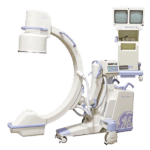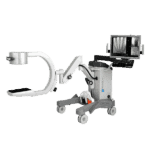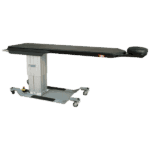Full size and mini C-Arms: What are the differences and what are they used for?
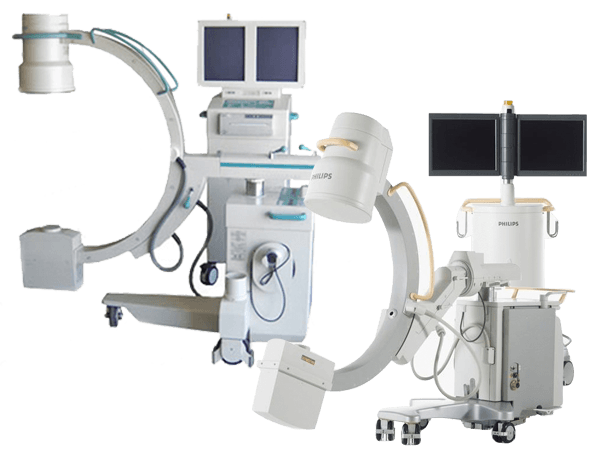
Full-size C-Arms
Full-size C-arms are more powerful and have more room to accommodate different parts of the body. There are many brands and types to choose from, for example, the OEC 9600, 9800, and 9900 by GE come with either flat plate detectors and/or image intensifiers. The 9” or 12” diameter analog image intensifiers are equipped with 3 magnification settings: 9/6/4.5 for 9’’ and 12/9/6 for 12”.
Digital C-arms, on the other hand, are equipped with 20 x 22 and 31 x 31 cm flat plate detectors which provides 100% coverage of the body part being worked on. Images can be viewed, edge to edge, with minimal distortion.
Full-size C-arms are required for hips, femurs, knees, shoulders, clavicles, lumbar and cervical spine cases. They are also used for vascular and urological work. They can generate up to 120 KVp and 4 mA which allows more penetrating power to visualize the hip joint, lumbar spine, and the femur.
The main con for a Full-size C-arm would be the space requirement, since they need a large enough room to be able to be moved around. It is also more difficult to move around the body part and needs to be pulled out to allow the surgeon to work around the patient.
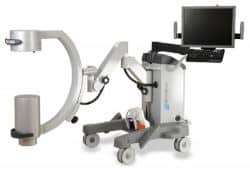
Mini C-Arms
Mini C-arms can stay in place without being moved in and out during the procedure. They are appropriate for extremity cases like hands, feet, ankles, and pediatric surgical procedures. Just like their larger counterparts they also come in different models and sizes such as analog and digital.
The advantages of Mini C-arms include their maneuverability, easier image accessibility, cuts delays, lower costs, less radiation exposure, and reduced screening time. But they also produce smaller images and less power and are also more fragile than their larger counterparts.
The larger C-Arm can be used for both small extremities and larger body parts
Smaller hospitals or medical practices with limited budgets can get by with the larger C-arms for all cases, including extremity cases, as the image intensifier and/or flat panel detector can be covered with a sterile drape and used as a worktable for operating on hands, feet, ankles, etc.
Get Started
Request Pricing Today!
We’re here to help! Simply fill out the form to tell us a bit about your project. We’ll contact you to set up a conversation so we can discuss how we can best meet your needs. Thank you for considering us!
Great support & services
Save time and energy
Peace of mind
Risk reduction
Do you need both C-arms?
It depends on the volume and operating budget. Full-size C-arms are required for larger cases such as vascular, urological and ortho work. Most hospitals have one or two C-arms that meet the surgical requirements.
The mini C-arm is a matter of convenience but not necessary for smaller extremities, unless the surgical volume is high. For example, the mini C-arm is ideal for extremity trauma surgery in the ER where the patient is too unstable to be moved to the OR.
The mini C-arm can come in handy for small extremities if the full-size C- arms are in use. Plus, with its smaller profile the mini can be used in smaller rooms or spaces.
To Sum up
The mini C-Arm is restricted to smaller body parts such as hands, feet, and wrists. They cannot be used for larger cases such as large ortho cases. They are suitable for small facilities such as immediate care, or smaller hospitals that do extremity work only. If the budget allows, the mini C-arm can be purchased for larger facilities as a back-up C-arm for smaller extremity cases.
The Full-size C-arms are required for femur roddings, vascular studies and urological work. They also can be used for small extremities such as hands and feet. They are ideal for departments with limited budgets that cannot afford both sizes. The full-size C-arm can be used for smaller extremities and larger surgical procedures.

